Kinhuron Imaging Center Kincardine (KICK)
Starbase Six Imaging Complex Kincardine (SSICK)Mission Statement
Having built several dome observatories in the past, I realized they have
their limitations under certain circumstances. I decided to build a roll off roof observatory
to compensate for those short comings. The demands of a fully robotic observatory are more easily
met with the roll off roof design. No dome rotation required, and the limitations of the dome slit vs.
equipment size is not a problem. Automated imaging is much simpler.
Starbase 6 is a 10 foot by 16 foot roll off roof observatory with two peirs, one with a Paramount ME Robotic Telescope Mount capable of
remote internet operation. Starbase 5 is an 8 foot Explora-Dome observatory housing a Losmandy G11 mount with an Astrometric Instruments SkyWalker
GOTO retrofit. Various telescopes will be utilized...a Takahashi FSQ ED106 f/5 refractor, a Takahashi Epsilon 180ED f/2.8 Astrograph, a 120mm
SkyWatcher refractor as well as a forth coming 12 inch f/4 Newtonian Astrograph.
Various CCD cameras....Starlight Xpress SXVH9C, SBIG STL11000M
(w/ Baader LRGB and HAlpha/O3/S2 narrow band filters)
Orion Deep Space Pro, and Orion Auto Guider.
The Starbase Six Imaging Complex consists of two observatories.......an eight foot Explora Dome
housing the Losmandy G11 facility and the 10'X16' Roll off Roof Observatory which houses the Paramount complex.
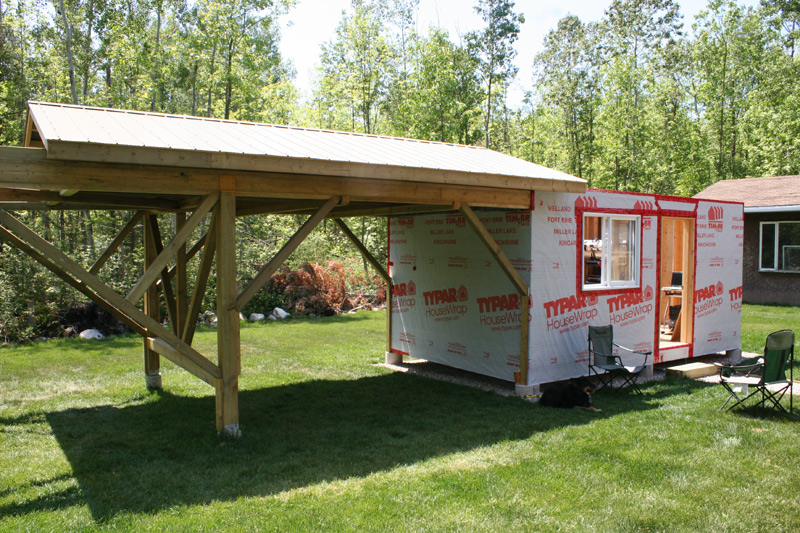
This shows the roof in the open position. A Foster System AMC100 unit will control
opening and closing of the roof remotely. All will be controlled from the comfort of the house
via a central computer which will control telescope and CCD camera in Starbase 5
and access the local computer in Starbase 6 via LAN cable. Portable Laptops
can also be used for individual control of each imaging platform.

This is the Explora Dome Observatory....Starbase 5.
It houses the Losmandy G11 mount and Takahashi FSQ for imaging
using a one shot Orion Deep Space Pro CCD camera.
Mainly used for low altitude imaging in the south.
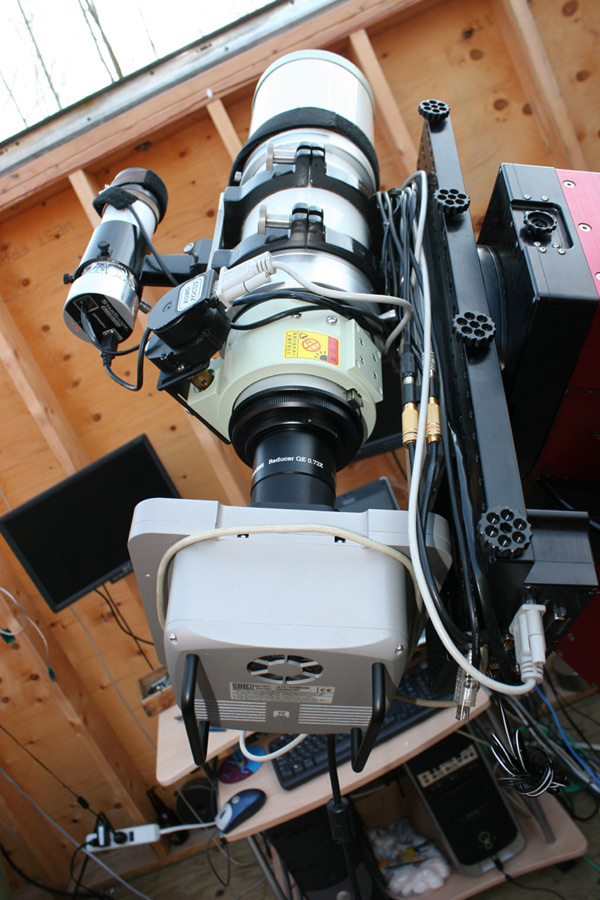
Here is the Takahashi FSQ and focal reducer with SBIG STL11000M camera and CFW8
which holds LRGB, Halpha, Hbeta, S2 and O3 filters. Note the finderscope fitted with
Orion Autoguider and the Robofocus unit.
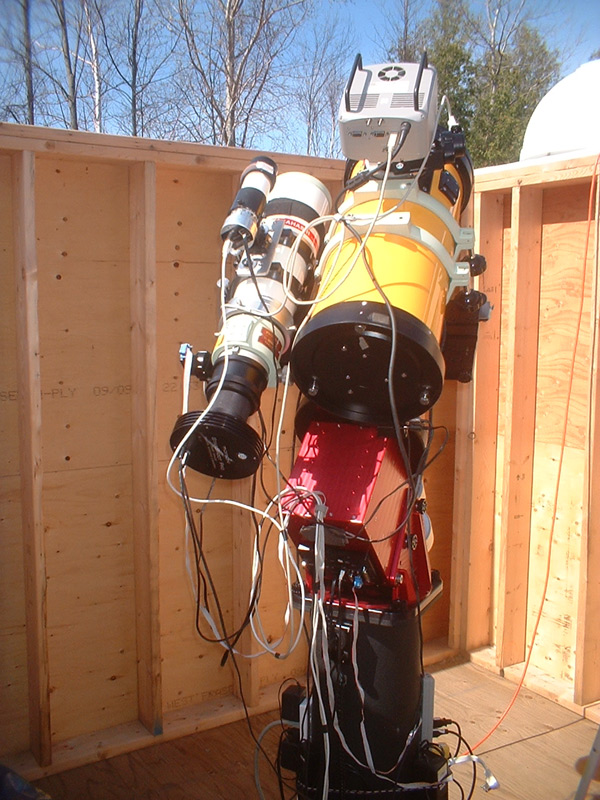
Tak FSQ with Orion camera beside Tak Epsilon SBIG combination.
Now, about those cables........

News Update: January 2011.... After two years of struggling with the "collimation" on this scope,
I finally realized my imaging anomalies were due to focus slop. I collimate with a cross hair laser,
Texas Nautical collimation disk (Replaces mirror for secondary collimation)
and a Cheshire eyepiece. I am well versed in the collimation process now. I had not considered the focuser
and one day I just noticed some slop as I adjusted it. A custom
Van Slyke focuser now replaces the original unit which simply could not
handle the weight of this heavy CCD camera. The Van Slyke unit was custom machined
for this scope. This unit promises zero flexure.....initial imaging tests confirm this....
pinpoint stars finally!! Readings using CCD Inspector have shown
consistent non-flexure conditions. This is a wonderful scope but the original focuser was simply inadequate.
The rest of the scope is built like a tank and now the focuser matches.
Setup as of January 2011....

Currently waiting for any clear skies.............
Note the Polyethylene track with the holes at top........
this is the drive track which runs down the middle of the roof.
The motor is housed in an enclosure outside of the observatory.
Top: Takahashi Epsilon 180 ED f/2.85 Astrograph w/
SBIG STL11000M CCD camera with
8 position filter wheel
and upgraded Van Slyke focuser
Bottom: Skywatcher 120mm f/7.5 guidescope
fitted with Orion Autoguider.
Note the cable management system of the Paramount.
I finally setup all neccessary cables through the internal cable setup.
Cables include extension for SBIG camera power supply, extra Robofocus cable,
3 USB cables for cameras and 12 vdc power supply.
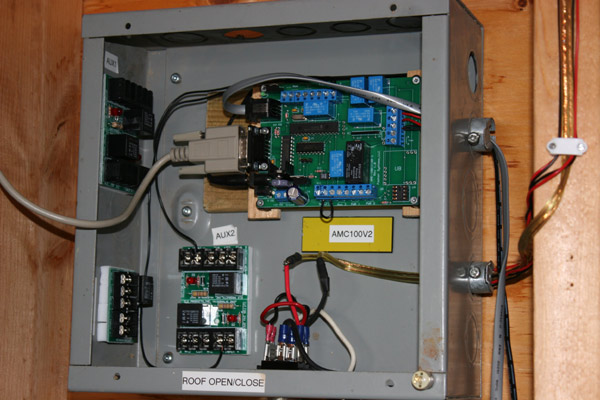
Here is the Foster Systems AMC100V2 control board. It is a component system
which currently features a weather monitor, magnetic roof proximity switches and contact
switches which operate relays that operate the roof motor as well as other devices. Auto roof control currently not commisioned.
The weather monitor watches ambient temperature, sky temperature in the IR (reflects sky clarity), humidity
and precipitation and is located outside the observatory of course.
At bottom is the manual roof open close toggle switch. The motor came originally with the Explora Dome
but was never installed. It's a 1/15 (yes one-fifteenth!) horsepower 12vdc motor with torque like crazy
and drives the roof open and close smoothly, a one way trip taking 47 seconds.
Below is the wiring diagram I finally came up with after much research and consultation.
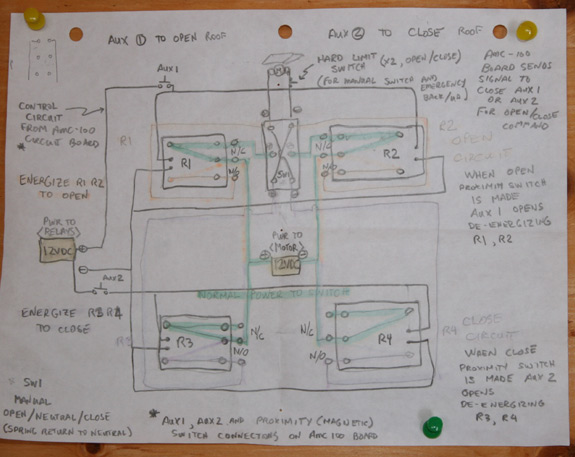
Below is a must for remote control setup. It is a remote power module
which connects to the Robofocus control box and allows you to turn on-off each
of the four 120 vac receptacles remotely from the Robofocus control program.
Currently, all I have to do is open the roof and remove the scope dust caps
manually. All other operations can be done remotely. Once the roof control is commisioned,
that, too, will be computer controlled. Possible future installation of FlipFlats (dust covers/flat field lights)
would render the entire operation remotely and automatically using CCD Auto Pilot software
which integrates all operations of an imaging run from powering up equipment, opening the roof,
taking images including calibration files, parking the scope and shutting down all equipment. Provisions
include emergency shutdown in inclement weather via the AMC100 weather monitor.
